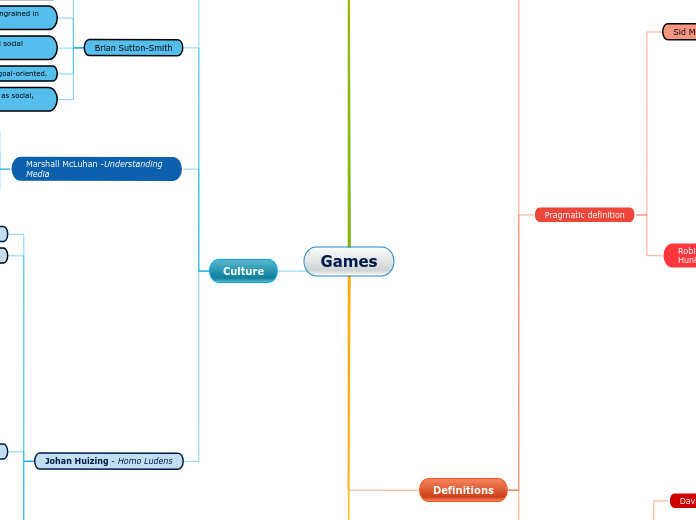によって Pascaline Natchedy 4年前.
335
Games

によって Pascaline Natchedy 4年前.
335

もっと見る
Ludus (formal, rule-based game behavior)
Paidia (playfulness)
Ilinx (vertigo)
Mimicry (imitation)
Alea (chance)
Agôn (competition)
Jesper Juul
Games are composed of 3 layers
Social context
Experience
Goal orientation
The concept of Magic Circle is misunderstood.
Critics of the Magic Circle
Games affect the real world
Actions in games extend into the real world.
Games influence our behavior.
Games are communication media.
Games impact our moods.
Time has to be allocated to games.
Mia Consalvo
Other factors such as social contexts are important.
Games shouldn't be considered as simply rule-based activities.
Thomas Malaby
A game is a continuous process that can create new meanings and practices.
Games are more than mere objects.
Edward Castronova
No philosophical argument to substantiate the concept of Magic Circle
Crucial to keep the game and real worlds separated
No empirical data to back up the idea of “catharsis”.
Superficial way of addressing problems
Alternate reality games
Blur the line between traditional game worlds(fiction) and the real world (reality)
Explains how information in games is meant to be interpreted
Nonverbal cues that carry meanings
Children take on different roles they observe in society.
Symbols are used to exchange ideas with each other through play and games.
A shared system of symbols
Classic game model
Some video games don't satisfy all the criteria of the classic definition of a game.
Not games -outside the classical model
Non-negotiated consequences
No attachment
Fixed outcome
Variable rules
Borderline cases
Pre-negotiated consequences
No player effort
No valorization of outcome
Flexible rules
Games - classic criteria
Negotiable consequences
Player attachment to outcome
Player effort
Valorization of outcome
Variable outcome
Fixed rules
There should be a quantifiable outcome.
A game has al least one conflict that challenges the player's skills and intellect.
A game has rules.
Games have 4 common elements
Safety
Games might have some direct impact on the real world.
Conflict
Interaction
Representation
First one to define video games
These conflicts are challenging but create excitement.
Games should exhibit some conflicts
Parlett’s definition is simultaneously too restrictive and wide-ranging.
Many games don't fit Patty's concept of a game.
Focuses on nonelectronic games
Games consist of two parts
Means
These are the resources, tools and rules players must abide to.
Ends
Games are competitions that have only one winner.
MDA model
Many aspects of the game experience are excluded in this model such as context and culture.
It's first and foremost a tool for designing games.
Pinpoints that games are systems and focuses on the way games work.
Aesthetics
A game can evoke multiple responses but not all of them.
There are 8 types of emotional responses.
Submission (game as pastime)
Expression (game as self-discovery)
Discovery (game as uncharted territory)
Fellowship (game as social framework)
Challenge (game as obstacle course)
Narrative (game as drama)
Fantasy (game as make-believe)
Sensation (game as sense-pleasure)
Describes the desirable emotional responses when a player interacts with the game.
Dynamics
Are the different actions that players can take in a game.
Mechanics
Refers to the series of algorithms, the rules and basic code of a game.
Meier's definition suit strategy games best.
Players intervene and affect the game through their respective choices.
Elaborates on the element of choices for players
Ludwig's native language doesn't differentiate formal games from informal ones.
Not enough empirical evidence to support this claim.
Games at most exhibited family resemblances.
No common definition to fit all games.
Process-Oriented Games
Main focus on exploring and interacting with the game
subgroup: simulation games
Strategy Games
hybrid of action and adventure games
real-time strategy and turn-based strategy games
Adventure Games
need logic thinking skills to solve challenges
Action Games
include lots of combats and physical drama
Some games are not goal-oreinted.
Single-player and multiplayer role-playing games don't perfectly fit this definition.
Limited practical use
Vague system of categorization
Related to the game's goals
What is displayed on the screen